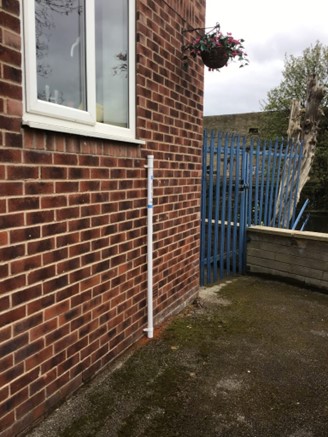Everything you need to know about your FloodFlash sensor?

The logistics of the FloodFlash sensor
Every FloodFlash policy comes with a smart sensor. It is the key to our rapid claims and affordable premiums. When the sensor measures flooding at the chosen trigger depth, we start the claim. Placing the sensor is the first step to getting FloodFlash cover in place, and the most important.
Where to place a FloodFlash flooding sensor?
FloodFlash have a few rules when it comes to sensor placement. They tell clients to follow the acronym PLACE:
Property
Level
Abuts
Cost
Engineer
Property: The sensor must be on the outside wall of the correct property. The quote submission form will include a satellite view if the stated property, and quotes are based on that property. To ensure a claim is valid, the sensor must be on this property.
Level: The sensor must be at or above ground level. It cannot be placed down a drain or stairway that leaves the bottom end of the sensor below ground level.
Abuts: The sensor cannot be on a wall that touches a river. This is for many reasons including false readings.
Cost: The sensor costs £100 plus VAT. This covers licensing and services. Initial installation is free.
Engineer: The client must instruct the engineer where to place the sensor according to the above rules.
Where exactly to place the Floodflash flooding sensor on your property?
Where exactly to place the sensor is down to you, it’s your choice. We recommend an elevation based approach, placing the sensor at the lowest point of elevation. As long as the PLACE rules are followed, the benefits of an elevation based approach is that this area is likely to flood first and allows for a higher trigger depth.
If you have flooded before, then you will know which area of your property is more likely to flood. Use a risk based approach and place the sensor in these areas – such as a wall next to a drain that regularly overflows, or where heavy rain builds.
Other considerations are aesthetics. Placing the sensor at the back of a property rather than the ‘shop-front’ is fine. It’s important the sensor is placed at the pre-agreed trigger depth. This means we can immediately tell when you have experienced a flood, paying out as soon as water enters your property.
 Image courtesy of FloodFlash
Image courtesy of FloodFlash
What is the installation process of a FloodFlash sensor?
No DIY is required. Once booked, FloodFlash’s team will arrange the delivery of the sensor. One of their trained installation engineers will call a day or so in advance to confirm arrangements.
Have the location chosen and cleared before the engineer arrives.
How does a FloodFlash sensor work?
After installation the sensor is self-sufficient, data is monitored regularly.
The sensor is custom-built to pay claims fast. Each sensor is smart – every sensor is equipped with high-accuracy, ultrasonic depth measurement technology. It sends flood data to FloodFlash HQ using the mobile networks. Each sensor is strong – the sensor is built to last. It features a battery that lasts up to 12 years and a memory chip to store data for when networks fail. And each sensor is secure – all our sensors are tamper and fraud proof. Plus, the simple installation means that we replace it quickly if needed. If you flood and the sensor fails, we still pay out, but no sensors have failed to date.
Contact us at Club Insure if your sensor has come away from the wall, broken or you want one!






